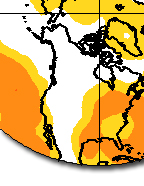|
|

Project Funding: $343,648
Funding Period: 8/1/07-7/31/10 Principal Investigator: Dr. Zong-Liang Yang Co-Investigators: Guo-Yue Niu Fei Chen (NCAR) David Gochis (NCAR) Collaborator: Kenneth Mitchell (NCEP/EMC) Also See: National Center for Atmospheric Research (NCAR) National Center for Environmental Prediction (NCEP) NOAA Climate Prediction Program for the Americas (CPPA) Improving Hydrological Representation in the Community Noah Land Surface Model for Intra-seasonal to Interannual Prediction Studies (GC07-075)Project Summary: Accurately predicting precipitation on intra-seasonal to interannual timescales in North America is critical for effective management of agriculture, water resources, and other societal needs, which is one of the primary objectives of the NOAA CPPA FY2007 Priorities. Despite significant progress in understanding physical processes and mechanisms controlling predictability of precipitation, the prediction skill is still limited. This limited skill may be due to an inadequate data record for surface boundary conditions (e.g., soil moisture), deficiencies in model parameterizations (e.g., surface hydrology), and improper initialization techniques for the prediction system. The proposed project will improve the prediction skill by
We propose to use the latest version of the unified Noah LSM, jointly maintained at NCEP and NCAR, to investigate how its augmentation with additional land memory processes (e.g. groundwater and dynamic vegetation) influences its soil moisture memory. We will apply the enhanced Noah in the continental USA to develop high-resolution datasets of land surface state variables (e.g., soil moisture) for a period of 2000–2004 in conjunction with NCAR’s high-resolution land data assimilation system (HRLDAS). We will then perform ensembles of simulations using the Weather Research and Forecasting (WRF) meso-scale model coupled to the Noah LSM. Initialized with HRLDAS land data, the simulations will illustrate the role of soil moisture, groundwater, vegetation, frozen soil, and snow in predicting precipitation at intra-seasonal to interannual timescales. We selected Noah because of its long heritage and extensive applications. Through previous funding, we have already tested different versions of Noah with the first four of the following submodels:
The proposed research is directly relevant to the CPPA FY2007 Priorities in “Predictability and Prediction Studies”. It is also relevant to other priorities including “Understanding and Predicting of Monsoon Systems in Americas”, “Improving Ensemble Hydrologic Prediction” and “CPPA Synthesis Projects”. |